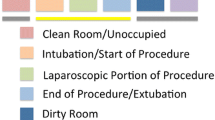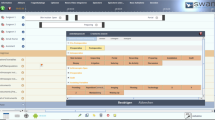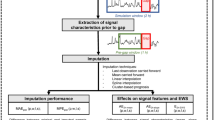Abstract
Objective
Sensor systems in the operating room may encounter intermittent data losses that reduce the performance of surgical workflow management systems (SWFMS). Sensor data loss could impact SWFMS-based decision support, device parameterization, and information presentation. The purpose of this study was to understand the robustness of surgical process models when sensor information is partially missing. SWFMS changes caused by wrong or no data from the sensor system which tracks the progress of a surgical intervention were tested.
Materials and methods
The individual surgical process models (iSPMs) from 100 different cataract procedures of 3 ophthalmologic surgeons were used to select a randomized subset and create a generalized surgical process model (gSPM). A disjoint subset was selected from the iSPMs and used to simulate the surgical process against the gSPM. The loss of sensor data was simulated by removing some information from one task in the iSPM. The effect of missing sensor data was measured using several metrics: (a) successful relocation of the path in the gSPM, (b) the number of steps to find the converging point, and (c) the perspective with the highest occurrence of unsuccessful path findings.
Results
A gSPM built using 30 % of the iSPMs successfully found the correct path in 90 % of the cases. The most critical sensor data were the information regarding the instrument used by the surgeon.
Conclusion
We found that use of a gSPM to provide input data for a SWFMS is robust and can be accurate despite missing sensor data. A surgical workflow management system can provide the surgeon with workflow guidance in the OR for most cases. Sensor systems for surgical process tracking can be evaluated based on the stability and accuracy of functional and spatial operative results.







Similar content being viewed by others
References
Lemke H, Vannier M (2006) The operating room and the need for an IT infrastructure and standards. Int J Comput Assist Radiol Surg 1:117–121
Neumuth T, Liebmann P, Wiedemann P, Meixensberger J (2012) Surgical workflow management schemata for cataract procedures. Process model-based design and validation of workflow schemata. Methods Inf Med 51:371–382
Neumuth T, Meißner C (2012) Online recognition of surgical instruments by information fusion. Int J Comput Assist Radiol Surg 7:297–304
Neumuth T, Jannin P, Schlomberg J, Meixensberger J, Wiedemann P, Burgert O (2010) Analysis of surgical intervention populations using generic surgical process models. Int J CARS 6:59–71
Welker A, Wolcke B, Schleppers A, Schmeck SB, Focke U, Gervais HW, Schmeck J (2010) Ablauforganisation im Operationssaal. Anaesthesist 59:904–913
Cone SW, Leung A, Mora F, Rafiq A, Merrell RC (2006) Multimedia data capture and management for surgical events: evaluation of a system. Telemed J E Health 12:351–358
Suzuki T, Sakurai Y, Yoshimitsu K, Nambu K, Muragaki Y, Iseki H (2010) Intraoperative multichannel audio-visual information recording and automatic surgical phase and incident detection. In: Conference, proceedings of IEEE Engineering in Medicine and Bioloy Society 2010, pp 1190–1193
Kranzfelder M, Schneider A, Gillen S, Feussner H (2010) New technologies for information retrieval to achieve situational awareness and higher patient safety in the surgical operating room: the MRI institutional approach and review of the literature. Surg Endosc 25:696–705
Krishnamurthy AH, Ravikumar R (2006) Fault tolerance in automotive systems. Sens Actuator A 132:370–375
Hoseinnezhad R, Bab-Hadiashar A (2005) Missing data compensation for safety-critical components in a drive-by-wire system. IEEE Trans Veh Technol 54:1304–1311
Workflow Management Coalition (1999) Terminology & glossary. Document number WFMC-TC-1011, Document Status—issue 3.0
Neumuth T, Jannin P, Strauss G, Meixensberger J, Burgert O (2009) Validation of knowledge acquisition for surgical process models. J Am Medi Inform Assoc 16:72–80
Van der Aalst WMP, Ter Hofstede AHM (2005) YAWL: yet another workflow language. Inf Syst 30:245–275
Van der Aalst WM, Aldred L, Dumas M, Ter Hofstede AH: Design and implementation of the YAWL system. In: Proceedings of the 16th international conference on advanced information systems engineering. Springer, Verlag, pp 142–159
PostgreSQL: The world’s most advanced open source database. http://www.postgresql.org/
The R project for statistical computing. http://www.r-project.org/
IBM SPSS Software für predictive analytics—Deutschland. http://www-01.ibm.com/software/de/analytics/spss/
Kataraktoperation: Risikominderung einer Blutung bei oraler Antikoagulation (10.01.2005). http://www.aerzteblatt.de/archiv/44945
Acknowledgments
The authors thank the team that supported the performance of the study and the preparation of the article at the Innovation Center for Computer Assisted Surgery, University of Leipzig: Caroline Elzner, Michael Thiele, and Alexander Oeser. ICCAS is funded by the German Federal Ministry of Education and Research (BMBF) and the Saxon Ministry of Science and Fine Arts (SMWK) in the scope of the Unternehmen Region with grant numbers 03 ZIK 031 and 03 ZIK 032 and by funds from the European Regional Development Fund (ERDF) and the state of Saxony within the framework of measures to support the technology sector.
Conflict of Interest
The paper is not, nor was it previously, under consideration by any other journal. The funding sources had no involvement in the study design, data collection, analysis or interpretation of the results, or in the writing of the report. All authors have no conflicts of interest. The decision to submit the paper for publication was ours alone.
Author information
Authors and Affiliations
Corresponding author
Rights and permissions
About this article
Cite this article
Liebmann, P., Meixensberger, J., Wiedemann, P. et al. The impact of missing sensor information on surgical workflow management. Int J CARS 8, 867–875 (2013). https://doi.org/10.1007/s11548-013-0824-8
Received:
Accepted:
Published:
Issue Date:
DOI: https://doi.org/10.1007/s11548-013-0824-8




